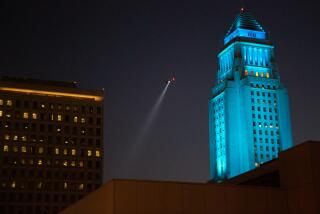Ex-Lockheed Chairman Says Jet Parts Were OK : Aerospace: During testimony in a wrongful-termination suit, Lawrence O. Kitchen said three auditors ‘lied’ about defective structures.
- Share via
Former Lockheed Chairman Lawrence O. Kitchen testified Thursday that the firm’s C-5B cargo jets do not contain defective structural parts, as alleged by three company auditors who were fired in 1985 by Kitchen and who later filed a wrongful termination suit.
Kitchen’s testimony came in the third week of the case, which was filed in Los Angeles Superior Court by former auditors Thomas R. Benecke, Terrence F. Schielke and Clyde W. Jones Jr.
The three auditors allege that improper heat treating of the main frames of the C-5B fuselage conducted at Lockheed’s plant in Burbank resulted in cracking, warping and other deformities starting in 1983.
The individuals said they were instructed by Lockheed audit department executives not to begin a formal investigation or write a report, but they continued to attempt to sound warnings of the problems within the company, according to earlier testimony.
In September, 1985, the three auditors met with Kitchen and disclosed that they had hired an outside metallurgist at their own expense and had found that samples of the structural parts were defective.
Kitchen said he personally fired Schielke and Benecke because they had acted unprofessionally, had failed to conduct a formal audit of their own allegations and had taken property off the company premises. Jones was retired after he was threatened with being fired, according to an internal Lockheed memorandum entered into evidence.
Herbert Hafif, an attorney representing Schielke and Benecke, said that Lockheed has admitted that it did not perform certain tests to certify that a heat-treating oven was operating at the correct temperature.
The auditors allege that the oven operated at too high a temperature and caused “eutectic melting,” in which certain metals inside the aluminum alloy melted during heat treating and created voids later on.
The voids allegedly occurred in the C-5B’s main frames, which are the most important of a series of circular structures or frames that form the fuselage of the aircraft. The frames were built and heat-treated by the Lockheed California Co. for the Lockheed Georgia Co., which was the prime contractor for the aircraft.
Kitchen said the auditors “lied” about the problem and “claimed there was a management cover-up and there was not.” Kitchen said he did not learn about the auditors’ concerns until the September, 1985, meeting, but Hafif asserted that Schielke had alerted Kitchen that a management cover-up was occurring in a 1984 meeting.
Kitchen said Schielke called his secretary in 1984 and said he wanted to have a meeting because there was a management cover-up going on. But Kitchen said Schielke used the meeting to complain about his lack of promotion. “I admonished him for getting the meeting under false pretenses,” Kitchen testified.
Kitchen said he did not learn anything about the alleged defects until the 1985 meeting with all three auditors. After the meeting, Kitchen testified that he began an investigation of the allegations, directing the probe himself. The three auditors were fired the next month on Oct. 25.
In a 1986 hearing before the House Energy and Commerce Committee, Kitchen testified that that the Air Force’s Materials Laboratory at Wright-Patterson Air Force Base in Ohio examined test specimens of the aircraft structure and verified Lockheed’s findings that there was nothing wrong with the airplane.
Benecke now works for Transtechnology, a Sherman Oaks company. Schielke works for Northrop. And Jones is retired in Tennessee. No specific monetary damages are being claimed. The trial is expected to continue for another two weeks.
More to Read
Inside the business of entertainment
The Wide Shot brings you news, analysis and insights on everything from streaming wars to production — and what it all means for the future.
You may occasionally receive promotional content from the Los Angeles Times.










